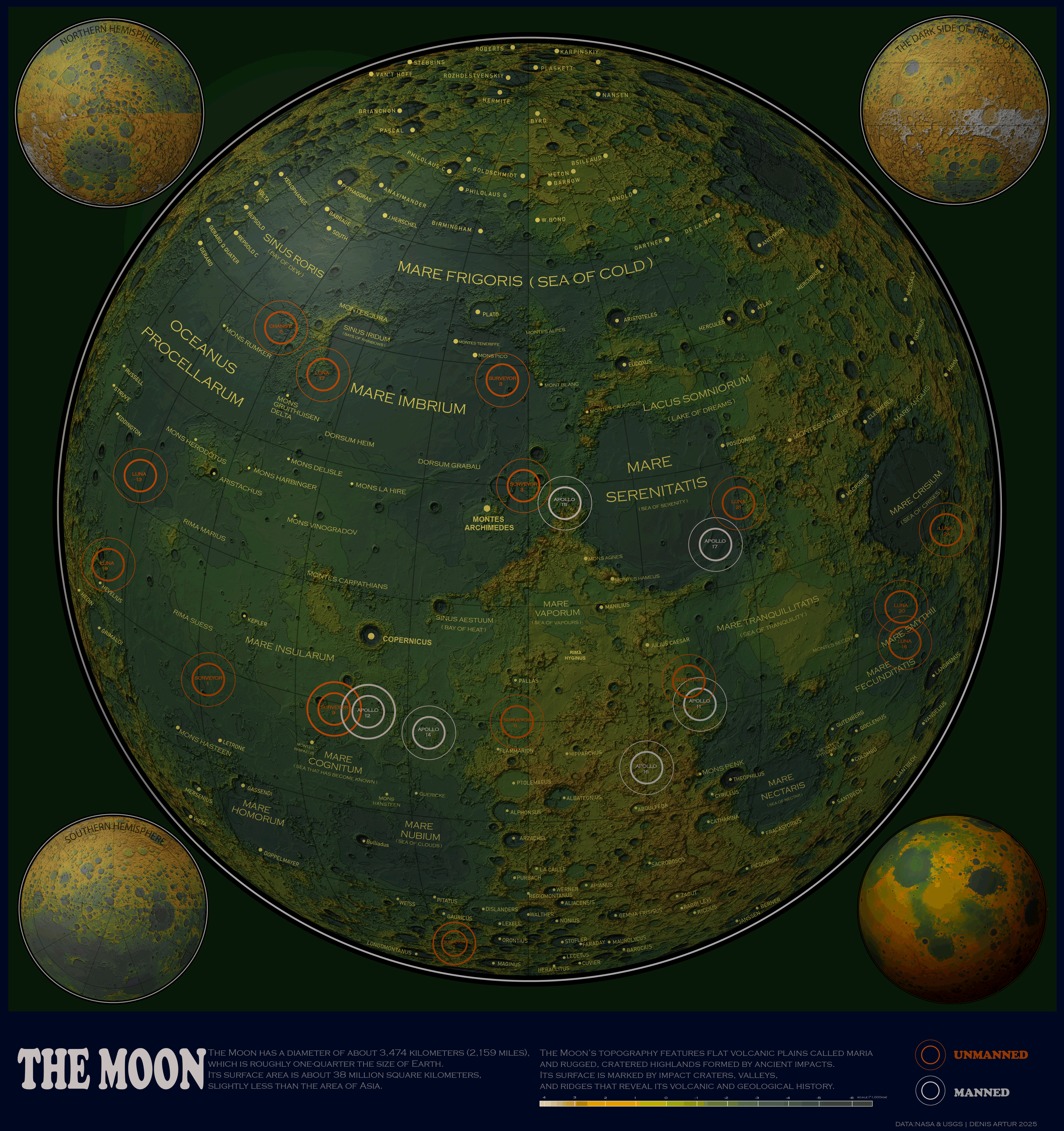Moon Landings Map: Manned and Unmanned Missions


Alex Cartwright
Senior Cartographer & GIS Specialist
Alex Cartwright is a renowned cartographer and geographic information systems specialist with over 15 years of experience in spatial analysis and data...
Geographic Analysis
What This Map Shows
The "Moon Landings Map: Manned & Unmanned Missions" provides a comprehensive visual representation of all the significant lunar explorations undertaken by humanity. It highlights both crewed missions, such as those from NASA's Apollo program, and various unmanned missions that have contributed to our understanding of the Moon. By pinpointing the exact landing sites of these missions, the map serves as a valuable tool for both educational purposes and scientific inquiry, allowing us to visualize the history of lunar exploration in relation to Earth.
Deep Dive into Lunar Exploration
Lunar exploration has been a pivotal chapter in the story of humanity's quest for knowledge beyond our planet. Since the dawn of the Space Age, the Moon has intrigued scientists, engineers, and dreamers alike. The first successful manned mission to the Moon was Apollo 11 in 1969, where astronauts Neil Armstrong and Buzz Aldrin became the first humans to set foot on another celestial body. This monumental event marked a significant milestone in space exploration and scientific research.
However, the journey to the Moon began long before Apollo 11. The Soviet Union launched Luna 2 in 1959, making it the first human-made object to reach the Moon. This unmanned mission paved the way for subsequent explorations, including Luna 9, the first mission to achieve a soft landing on the lunar surface in 1966. What's fascinating is how these early missions laid the groundwork for our understanding of the Moon’s geology, environment, and potential resources.
Throughout the 1960s and 1970s, NASA executed a series of Apollo missions, culminating in Apollo 17 in 1972, which was the last time humans visited the Moon. These missions not only focused on exploration but also brought back a wealth of lunar samples, providing invaluable data on the Moon's composition and history.
In the decades following the Apollo program, unmanned missions continued to play a crucial role in lunar exploration. Notably, missions like the Lunar Reconnaissance Orbiter (LRO), launched in 2009, have mapped the Moon’s surface in unprecedented detail. The data collected by LRO has been essential for identifying potential landing sites for future missions, including the Artemis program, which aims to return humans to the Moon in the coming years.
Interestingly, international collaboration in lunar exploration has expanded significantly over the years. Countries such as China and India have launched their own missions, with China's Chang'e program achieving remarkable successes, including the soft landing of Chang'e 4 on the far side of the Moon in 2019. This mission highlighted not only China's advancements in space technology but also the importance of international cooperation in pursuing scientific discovery.
Regional Analysis
When examining the Moon landings through the lens of the map, we can see distinct regional patterns in lunar exploration. The Sea of Tranquility (Mare Tranquillitatis) is notably where Apollo 11 landed, a site chosen for its relatively flat terrain, making it ideal for landing. In contrast, the Apollo 12 landed in the Ocean of Storms (Mare Nubium), showcasing how mission planners considered geological diversity when selecting landing sites.
The map also illustrates the impressive range of landing sites for unmanned missions across the Moon. For example, the Lunar Orbiter missions targeted various regions for high-resolution imaging, significantly enhancing our understanding of the Moon’s surface features, including craters and maria. Moreover, the data from these missions have helped scientists identify potential resources, such as water ice in permanently shadowed craters at the lunar poles, which could be vital for future human colonization.
Differences in landing sites reflect the evolving goals of lunar exploration. Early missions aimed primarily at understanding the Moon’s surface and environment, while more recent missions focus on preparing for future human presence. Countries like India and China have also selected sites that offer unique scientific opportunities, such as studying the Moon's geology and testing new technologies.
Significance and Impact
The significance of lunar exploration cannot be overstated. It has reshaped our understanding of the cosmos, provided insights into the history of our solar system, and inspired generations of scientists and explorers. The data collected from both manned and unmanned missions have implications for future space missions, including the potential for establishing a human presence on the Moon as a stepping stone to Mars.
Moreover, the Moon serves as a natural laboratory for scientific research. It allows scientists to study the effects of low gravity on human physiology, test new technologies for sustainable living in space, and investigate lunar resources that could support long-term exploration.
As we look to the future, trends suggest that lunar exploration will continue to expand, with numerous nations and private companies planning missions to the Moon. The Artemis program, aiming for a sustainable human presence on the Moon by the late 2020s, symbolizes a new era of collaboration in space exploration. With the Moon map as a guide, we can anticipate exciting advancements in our quest to explore the final frontier.
Visualization Details
- Published
- October 7, 2025
- Views
- 30
Comments
Loading comments...